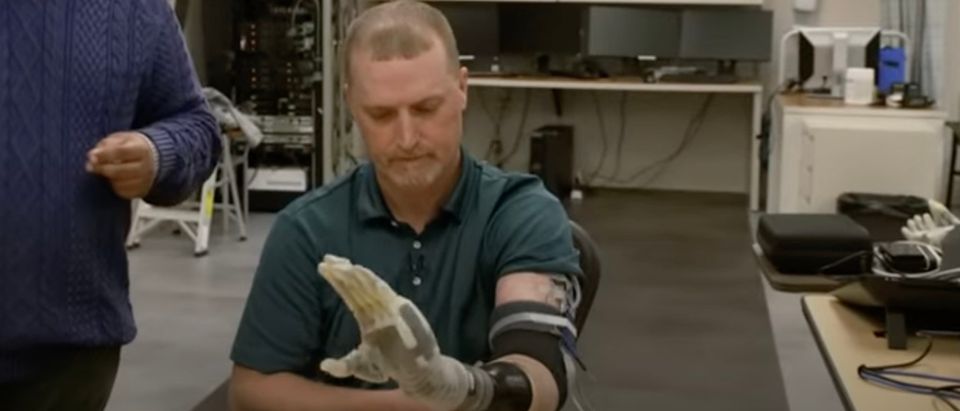Advanced prosthetic technologies have restored a sense of touch for an amputee and are assisting others with spinal injuries to feel “whole” again, CBS News reported Sunday.
Brandon Prestwood lost his left hand in 2012 after someone turned on an industrial conveyor belt he was reassembling. After years of using a hook to replace the hand he had lost, Prestwood volunteered to try out experimental prosthetics in a project sponsored by the Department of Defense (DOD) and Veterans Affairs which has given him back a basic sense of touch, CBS News reported.
“It doesn’t feel exactly like my right hand. It’s a tingling sensation,” Prestwood told the outlet. “It’s not painful. It’s kind of like, if your hand’s been asleep, right at the end, right before it wakes up … for me, it’s pleasant, it’s a pleasant tingling.”
Strides in prosthetic technology allow amputees and those with brain-controlled robotic limbs to feel a sense of touch using advanced prosthetic technology. Scott Pelley reports on breakthrough advances for @60Minutes. https://t.co/vTW904zx1N
— CBS News (@CBSNews) March 27, 2023
Prestwood’s advanced prosthetic hand can be controlled with his thoughts through electrodes implanted in the muscles in his arm. Sensors located in the fingers of the prosthetic, connect to a computer, which then sends signals to the nerves in his arm allowing him to “feel” whatever is in his prosthetic hand, the outlet reported.
The movement to “revolutionize prosthetic limbs” began seventeen years ago when the DOD launched a $100 million research project involving 300 engineers, neuroscientists and psychologists in order to help service members injured in the line of duty to get some sense of normalcy back into their lives.
“We have a saying in the military, ‘Leave no one behind.’ And we are very serious about that. And that doesn’t mean just on the battlefield, but also back at home,” Dr. Geoffrey Ling, an Army colonel and neurologist over the Revolutionizing Prosthetics program, told CBS News in 2009. (RELATED: Human Trials Next For DARPA’s Mind-Controlled Artificial Arm)
The University of Chicago’s Sliman Bensmaia, a leading expert on the neuroscience of touch, joined the DOD research project in 2008 and was initially skeptical over its success. “There are 100 billion neurons in the brain interconnected with 100 trillion synapses,” Bensmaia told CBS News. “I mean, the human brain, it’s like the most complex system in the known universe.”
Yet as research continued, Bensmaia and other researchers found that by targeting the right neurons with electrical stimulation in volunteers they were getting positive results even with those with spinal injuries. One such researcher, Dustin Tyler, a biomedical engineer who leads the research at Case Western Reserve University and the Cleveland Veterans Affairs, began his foray into electrical stimulation in 2012 when he used the electrodes and sensors on a volunteer, CBS News reported.
“So I was concerned, would it be his whole hand? Would it be painful? Would it not feel anything? We had no idea,” Tyler told the outlet. “So, one of those big moments in my career was, he came in, we first turned on the stimulus, and he kinda stopped for a second and he goes, ‘That’s my thumb. That’s the tip of my thumb.'”
As research continues, so do the advancements in the technology used in the prosthetics with Prestwood’s next device expected to run with Bluetooth technology instead of wires, the outlet reported. Though the cost is substantial at $200,000 for the experimental limb and surgery, Prestwood told the outlet being able to feel his wife’s hand in his again was worth it.
“I was a whole person again,” Prestwood stated.


